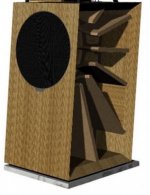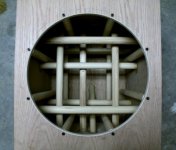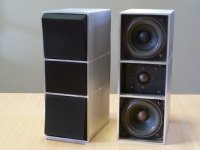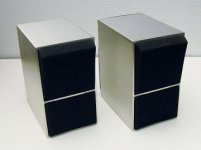Post #78 by Camplo shows a very thorough bracing strategy. I do something similar. It is not overkill, it is just about managing risk. It does not make a good sounding speaker sound better... but it greatly reduces the risk of an intrusive cabinet resonance. It virtually eliminates the risk that an otherwise fine speaker performance is wrecked by a structural defect.
This high stiffness approach is not difficult, and it does not require guess work or hard-to-find exotic material. It IS a lot of work, however.
We know that both the CLD approach and the high stiffness approach both can work, both can result in a low-signature cabinet. There are very excellent examples of both. But for a one-off DIY cabinet, with our current knowledge, the high stiffness approach is the most reliable way to achieve a low-signature cabinet.
The difficulty up till now with CLD approach is that by adding damping and mass to an un-braced plywood / MDF cabinet, we actually make things worse before we make them better. We are lowering the Q of the structural resonances, and lowering the frequency, both of which makes them more audible. It is only after we have added the necessary amount of damping and mass that we cross the threshold to be low-signature.
I am hoping that the work of Augerpro can give us a CLD alternative for those situations where lots of bracing is not practical. I have high hopes.
Now perhaps an aluminum cabinet is yet another alternative... but I have my doubts.
This high stiffness approach is not difficult, and it does not require guess work or hard-to-find exotic material. It IS a lot of work, however.
We know that both the CLD approach and the high stiffness approach both can work, both can result in a low-signature cabinet. There are very excellent examples of both. But for a one-off DIY cabinet, with our current knowledge, the high stiffness approach is the most reliable way to achieve a low-signature cabinet.
The difficulty up till now with CLD approach is that by adding damping and mass to an un-braced plywood / MDF cabinet, we actually make things worse before we make them better. We are lowering the Q of the structural resonances, and lowering the frequency, both of which makes them more audible. It is only after we have added the necessary amount of damping and mass that we cross the threshold to be low-signature.
I am hoping that the work of Augerpro can give us a CLD alternative for those situations where lots of bracing is not practical. I have high hopes.
Now perhaps an aluminum cabinet is yet another alternative... but I have my doubts.
"We know that both the CLD approach and the high stiffness approach both can work, both can result in a low-signature cabinet. There are very excellent examples of both. But for a one-off DIY cabinet, with our current knowledge, the high stiffness approach is the most reliable way to achieve a low-signature cabinet.
"
@hifijim, that's the thing-- weight has nothing to do with either of these and yet if a cab is super light it still gets dunked on for one reason or another. Weight must be present for a well performing build (that's the implicit narrative); no one has come right out and said this but it's there between the lines. Camplo says as much in response to the suggestion for CLD on a lightweight construction. It's as if a lightweight composite is acknowledged as being stiff, but not actually regarded as being stiff.
"
@hifijim, that's the thing-- weight has nothing to do with either of these and yet if a cab is super light it still gets dunked on for one reason or another. Weight must be present for a well performing build (that's the implicit narrative); no one has come right out and said this but it's there between the lines. Camplo says as much in response to the suggestion for CLD on a lightweight construction. It's as if a lightweight composite is acknowledged as being stiff, but not actually regarded as being stiff.
MOE as in modulus of elasticity, right? If I'm following, it sounds like using the inherent ring of a light/stiff panel at a desired frequency where you then clamp it down via a top weight or use a base that will soak up the resonance. Very nice little tricks!
Correct. Following quite well! 🙂
That, or combine them if blessed with a strong back and/or cheap labor, i.e. increase stiffness by adding mass in the form of increased thickness: What MDF thickness is acceptable?
In the past I have posted about the basic physics of vibrating cabinets in an effort to counter some of the wishful thinking expressed here about the roles of stiffness, mass and damping in the presence of resonances. It seems to have had very limited if any effect making me wonder if another effort would be worthwhile or even welcome?
To address the OP aluminium is almost certainly a superior material to wood for speaker cabinets if you are able to work with it effectively. This likely requires the ability to cast, calculate the properties of complex 3D geometries in terms of vibration and external shape to guide the sound, bond aluminium to aluminium (possibly), bond damping to aluminium, etc... Genelec being an obvious example. Unfortunately for almost all of us DIYers we simply don't have this sort of capability or access to it for hobby prices. Wood on the other hand is relatively cheap and easy to work with using modestly priced tools in a garage.
To address the OP aluminium is almost certainly a superior material to wood for speaker cabinets if you are able to work with it effectively. This likely requires the ability to cast, calculate the properties of complex 3D geometries in terms of vibration and external shape to guide the sound, bond aluminium to aluminium (possibly), bond damping to aluminium, etc... Genelec being an obvious example. Unfortunately for almost all of us DIYers we simply don't have this sort of capability or access to it for hobby prices. Wood on the other hand is relatively cheap and easy to work with using modestly priced tools in a garage.
Last edited:
Here is another example of what matrix bracing is
This is one example of bracing that, to me, borrows from folded transmission lines, without actually being one. Full width panels, spaced inside. The panels create the bracing needed to create inert baffles, like matrix bracing, but the division of the air space create higher modes for the airmass as well...something matrix bracing does not do...The air mass inside an enclosure vibrates... by splitting up the body of air, the air mass modes raise in frequency as well, and move towards being less energetic. At this point we are addressing not just the enclosure panel resonance but the resonance of the airmass and its effects on the drivers response. These ideas combined with CLD should make for a pretty quiet box?
I have CLD in my design, but not initially by intentional inspiration. There is a look I was going for that involved epoxy sand mortar on the exterior. My boxes are pretty big so I figured mass was already in my favor.
Attachments
Last edited:
Does anyone have any idea how and what to seal the gaps with of an aluminum box?
edit: I can't really recall it very well but I think I read very long time ago that, (was it?), silicon isn't enough and will come loose, anyhow it must be something that sticks very well to aluminum.
edit: I can't really recall it very well but I think I read very long time ago that, (was it?), silicon isn't enough and will come loose, anyhow it must be something that sticks very well to aluminum.
Last edited:
Duct Seal or similar: https://www.amazon.com/Ideal-Indust...ocphy=9010955&hvtargid=pla-523518281223&psc=1
Last edited:
You want to compare it to bird construction? Pick one up after it's flown into a window pane, it's more mush than intact IME, so not a valid example.
.
He said,
'Bird Bones'
Excellent thread, however .....
I picked up a pair of Radio Shack Minimus 11 aluminum speakers for $10 at a garage sale. They were dusty, dusty, with rotten drivers.
But with some elbow grease, they turned out well.

But with some elbow grease, they turned out well.
Gallien Krueger Guitar and Bass amplifiers and combos, made cabinets straight out of cut, punched and folded 2mm aluminum sheet 😱
Lots of screws holding everything together, as well as reinforcing ribs:


A real Road Warrior, better as an example because nicks and scratches show the actual Aluminum under the paint.
EDIT: notice the relatively thin folded aluminum sheet construction, as well as the sealing compound to seal joint and somewhat dampen vibration.

Lots of screws holding everything together, as well as reinforcing ribs:
A real Road Warrior, better as an example because nicks and scratches show the actual Aluminum under the paint.
EDIT: notice the relatively thin folded aluminum sheet construction, as well as the sealing compound to seal joint and somewhat dampen vibration.

Last edited:
- Home
- Loudspeakers
- Multi-Way
- Aluminium speaker cabinets




